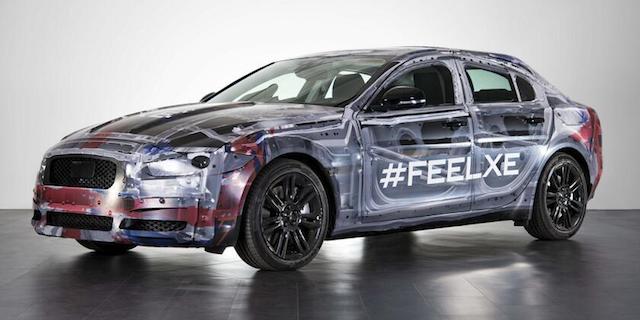
Jaguar has used social media to reveal the shape of its XE sedan, the all-aluminium mid-sized model it will aim squarely at German rivals when it goes on sale next year. The teaser image (above) shows the car’s profile for the first time – aided by a transparent camouflage of sorts to show what’s beneath the car’s skin. Another image (below) shows the front of the car. The XE has been engineered for rear- and all-wheel drive and marks Jaguar’s return to the mid-sized premium segment after it cut the Ford-based X-Type from its line-up in 2009. The XE will debut at the Paris motor show in October, where Jaguar is expected to reveal more about the new range of British-built engines it will use in future models. They belong to the ‘Ingenium’ family of go-faster turbocharged petrol and diesel units, some capable of a top speed of 300km/h, others emitting less than 100gr/km of C02. The XE will get four-cylinder 2.0-litre petrol and diesels of varying power before Jaguar reveals its stonker – the supercharged 3.0-litre petrol V6 from the F-Type sports car. It is expected to generate either 250kW/450Nm or 280kW/460Nm to allow the XE to take on the likes of the Audi S4/RS4, BMW M3, and Mercedes-Benz C63 AMG. Jaguar will also develop an SUV off the XE’s all-aluminium platform.
It was previewed as the C-X17 at the Frankfurt motor show last year and will be aimed at rivals like the BMW X3 and Audi Q5. Jaguar Land Rover’s expertise with aluminium has attracted interest from rivals like Mercedes-Benz, Audi, Ford and others. Indeed, Ford will begin production later this year of its aluminium F-150 pick-up truck. Executives from the rival companies have visited the JLR plant in Britain to learn more about aluminium production. And JLR is happy to show them the ropes, because it wants the carmaking industry to adopt standards to build aluminium vehicles. At present, carmakers using aluminium content in vehicles each use different manufacturing techniques – different glues, rivets, measuring methods and so on. JLR wants a universal standard that would cut production costs and save each manufacturer money. Already, its rivals are showing interest in the proposal.

